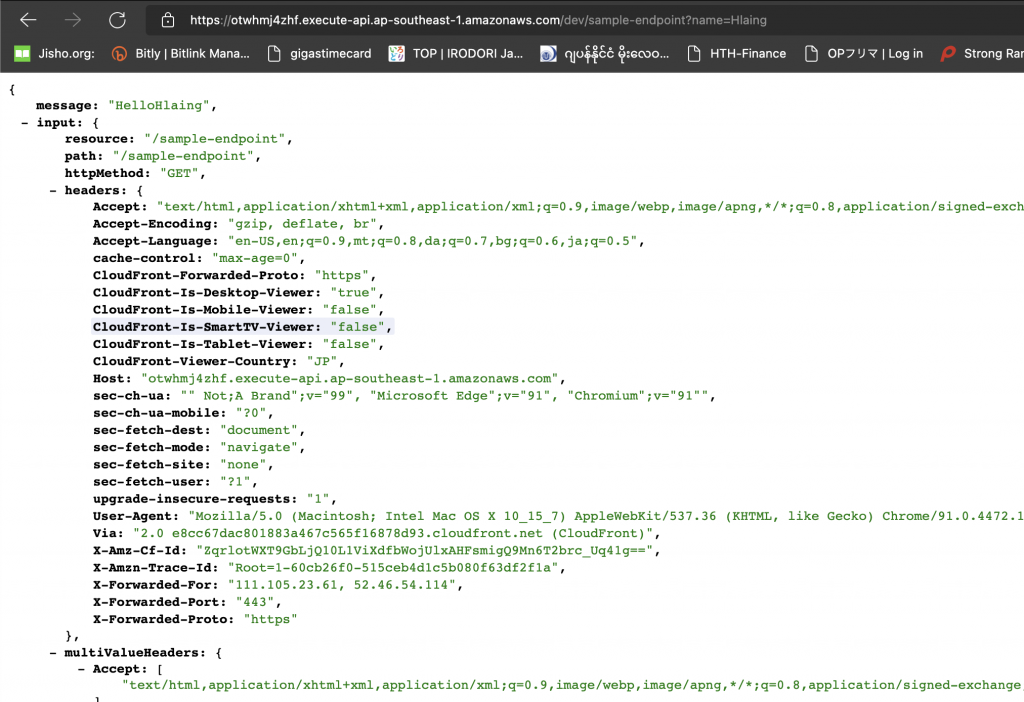アプリ関連ニュース
- 2021年7月12日
- Web Service
A touch to serverless framework – final part
We have created our serverless endpoint last week and lets tweak a bit more today by adding some parameters to our endpoint. Lets get started.
We don’t have to modify serverless.yml and lets keep the same way we did before.
events:
- http:
path: sample-endpoint
method: GETLets modify the handler.js as we are adding a name parameter to our endpoint and get a different response depending on the input parameter. We will add a conditional statement for our name parameter in our handler.js like this.
if (event.queryStringParameters && event.queryStringParameters.name) {
return {
statusCode: 200,
body: JSON.stringify(
{
message: 'Hello' + event.queryStringParameters.name,
input: event,
},
null,
2
),
};
}So this will be our final result of handler.js
'use strict';
module.exports.hello = async (event) => {
if (event.queryStringParameters && event.queryStringParameters.name) {
return {
statusCode: 200,
body: JSON.stringify(
{
message: 'Hello' + event.queryStringParameters.name,
input: event,
},
null,
2
),
};
}
return {
statusCode: 200,
body: JSON.stringify(
{
message: 'Go Serverless v1.0! Your function executed successfully!',
input: event,
},
null,
2
),
}
};
Lets deploy our code and see the result.

Lets go to the endpoint from the browser but this time we will add a name parameter at the end of the url like this
?name=HlaingAs a final result, we will get a response like this.

You can see the result of our name parameter in the json response of message data.
That’s all for today and we have successfully added a new parameter to our endpoint.
As a conclusion note, I have to say we can still do many things through this serverless project. We can also create other method type endpoint like POST. We can also create services like S3 buckets, DBs and so on through serverless.yml and deploying it. But let me stop the article series here as I also intended to get you a starting point to the serverless framework and I think you got it.
See you again . Yuuma
yuuma at 2021年07月12日 11:00:25
- 2021年7月09日
- 技術情報
Creating a simple GridView in flutter
During studying flutter, I learned a beautiful and simple grid system. These interesting and simple grid view layout topics I would like to share you today.
Ever created with a multiple layout with multiple rows within a column?
Try a GridView! While there are multiple GridView constructors, the most common way to create a GridView is the count constructor.
GridView.count(
..
..
)Start by listing all the items you want in the grid,
GridView.count(
children: [allItems],
)but it doesn’t end there, control how many items you want to across the grid, by setting the crossAxisCount property.
GridView.count(
crossAxisCount: 1,
children: [allItems],
)Setting it to 1 makes it look like a normal list. And if your items want to some social distancing? Use mainAxisSpacing gives horizontal space between the rows and crossAxisSpacing provides vertical space between the columns.
GridView.count(
mainAxisSpacing: 28.0,
crossAxisCount: 2,
children: [allItems],
)Now Let’s make simple grid view using GridView.count constructor.
GridView.count(
primary: false,
padding: const EdgeInsets.all(20),
crossAxisSpacing: 10,
mainAxisSpacing: 10,
crossAxisCount: 2,
children: <Widget>[
Container(
padding: const EdgeInsets.all(8),
child: const Text("He'd have you all unravel at the"),
color: Colors.teal[100],
),
Container(
padding: const EdgeInsets.all(8),
child: const Text('Heed not the rabble'),
color: Colors.teal[200],
),
Container(
padding: const EdgeInsets.all(8),
child: const Text('Sound of screams but the'),
color: Colors.teal[300],
),
Container(
padding: const EdgeInsets.all(8),
child: const Text('Who scream'),
color: Colors.teal[400],
),
Container(
padding: const EdgeInsets.all(8),
child: const Text('Revolution is coming...'),
color: Colors.teal[500],
),
Container(
padding: const EdgeInsets.all(8),
child: const Text('Revolution, they...'),
color: Colors.teal[600],
),
],
)The result is!

By Ami
asahi at 2021年07月09日 10:00:37
- 2021年7月08日
- 技術情報, Web Service
sourcetree/githubでの認証エラーの対処方法
nishida at 2021年07月08日 10:00:48
- 2021年7月05日
- Web Service
A touch to serverless framework – part 3
I wrote about setting up our severless project and deploying to the AWS last week. Today I will talk about invoking our functions and creating endpoints as I mentioned before. So lets get straight to it.
Function Invoking
Lets invoke our function which means execution of the serverless function. In invoking function, we can invoke either locally or cloud way.
Invoking locally
Go to your project root directory and run this command which invoke our function locally before submitting to the cloud.
sls invoke local --function helloThis will call to hello function and give a response like this.

Invoking Cloud (Cloud execution)
sls invoke --function helloThis will also invoke our function but not from our local code. This will hit our function hello from the cloud and give us a response.

Creating Endpoints
Lets create a simple endpoints first before we tweak a bit more later. Remember the endpoint will be hit up when a specific event will come up which is the main concept of serverless (Event). So if we want to create an endpoint , we also need to create an event.
Go to serverless.yml and find the functions parts and we will add an event and endpoint like this. Please be careful about the indentations as the yml file is sensitive.
functions:
hello:
handler: handler.hello
events:
- http:
path: sample-endpoint
method: GETWe added an endpoint called sample-endpoint which is a GET method type and we have linked our endpoint with the hello function. Now lets deploy our project again.
sls deployAs a result , we will get a response like this.

You will see that we get an URL under the endpoints section which is the main response result of our function hello. Lets copy that URL and paste it in browser.

Voila ! Our endpoint works successfully. That is all for this week. I will be talking about tweaking our endpoint a bit more in next week.
Thanks for reading. Yuuma
yuuma at 2021年07月05日 11:29:53
- 2021年7月01日
- Windows
Windows11が発表されました!
先週6月24日にMicrosoft社がWindows10の次期バージョン「Windows11」の発表をおこないました。
今回はWindows11の発表内容で気になった点や感想などをシェアしたいと思います。
nishida at 2021年07月01日 10:00:40